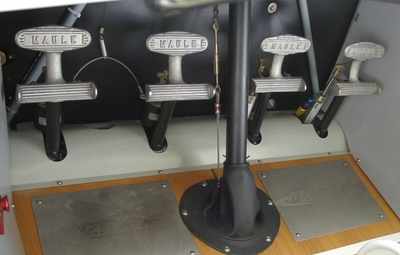Aero-Tips!
A good pilot is always learning -- how many times have you
heard this old standard throughout your flying career? There is no
truer statement in all of flying (well, with the possible exception
of "there are no old, bold pilots.")

Aero-News has called upon the expertise of Thomas P. Turner,
master CFI and all-around-good-guy, to bring our readers -- and us
-- daily tips to improve our skills as aviators. Some of them, you
may have heard before... but for each of us, there will also be
something we might never have considered before, or something that
didn't "stick" the way it should have the first time we memorized
it for the practical test.
Look for our daily Aero-Tips segments, coming each day to
you through the Aero-News Network.
Aero-Tips 06.25.06
Trim your airplane for level flight in smooth air. Take your
feet off the rudder pedals, then move the controls to bank the
wings (left or right). Watch carefully to where the airplane's nose
points. In many designs the nose will swing in the direction
opposite wing bank. You've just seen the effect of adverse yaw.
Adverse yaw results from the drag of deflected ailerons. Say you
move the controls to the right-the right aileron goes up, and the
left aileron goes down. The "spoiler" effect of the raised right
aileron reduces lift on that side and banks the wing to the right,
but the lowered left aileron creates more drag that tends to resist
the turn. The draggier the aileron (based on airplane type) the
more pronounced the resulting yaw away from the direction of
turn.
In some airplanes -- especially antique, tailwheel types --
there may be so much "aileron drag" that you can steer the airplane
on the ground using adverse yaw. This can actually be helpful
taxiing, taking off and landing in a crosswind.
Overcoming adverse yaw
Of course properly using the rudder overcomes this effect, by
moving the airplane's nose back in the direction of the turn. The
amount of rudder deflection needed will vary with the airspeed,
power setting and the specific airplane type -- part of the fun of
checking out in a new type of airplane is learning how to maintain
perfect rudder coordination.

There are a couple of design philosophies that help minimize
adverse yaw:
- Frise ailerons are hinged so that the leading
edge of an upward-deflected aileron extends downward beneath the
wing. This creates drag on the up-aileron to counter that created
by the down-aileron. The tradeoff: more total drag, causing reduced
airplane performance.
- Differential ailerons are rigged so ailerons
do not deflect downward as far as they do upward. There's less drag
created by the down-aileron, so less adverse yaw results. Drawback:
reduced aileron effectiveness and lower roll rate.
- Aileron/rudder interconnects in some airplanes
couple the aileron and rudder controls so a movement of one creates
a movement of the other. Bank the airplane with ailerons and the
rudder will displace enough to compensate for adverse yaw.
Shortcomings: the effect is precise through a small range of
airspeeds, power settings and bank angles. These interconnects also
encourage "feet on the floor" flying, leading to sloppiness in
flight regimes needing active rudder input and when the
interconnect-acclimatized pilot flies an airplane requiring more
rudder control.
Aero-tip of the day: Actively use whatever
rudder input is necessary to overcome adverse yaw.
 ANN's Daily Aero-Linx (04.16.24)
ANN's Daily Aero-Linx (04.16.24) Aero-News: Quote of the Day (04.16.24)
Aero-News: Quote of the Day (04.16.24) Airborne 04.10.24: SnF24!, A50 Heritage Reveal, HeliCycle!, Montaer MC-01
Airborne 04.10.24: SnF24!, A50 Heritage Reveal, HeliCycle!, Montaer MC-01 Airborne 04.12.24: SnF24!, G100UL Is Here, Holy Micro, Plane Tags
Airborne 04.12.24: SnF24!, G100UL Is Here, Holy Micro, Plane Tags Airborne-Flight Training 04.17.24: Feds Need Controllers, Spirit Delay, Redbird
Airborne-Flight Training 04.17.24: Feds Need Controllers, Spirit Delay, Redbird




